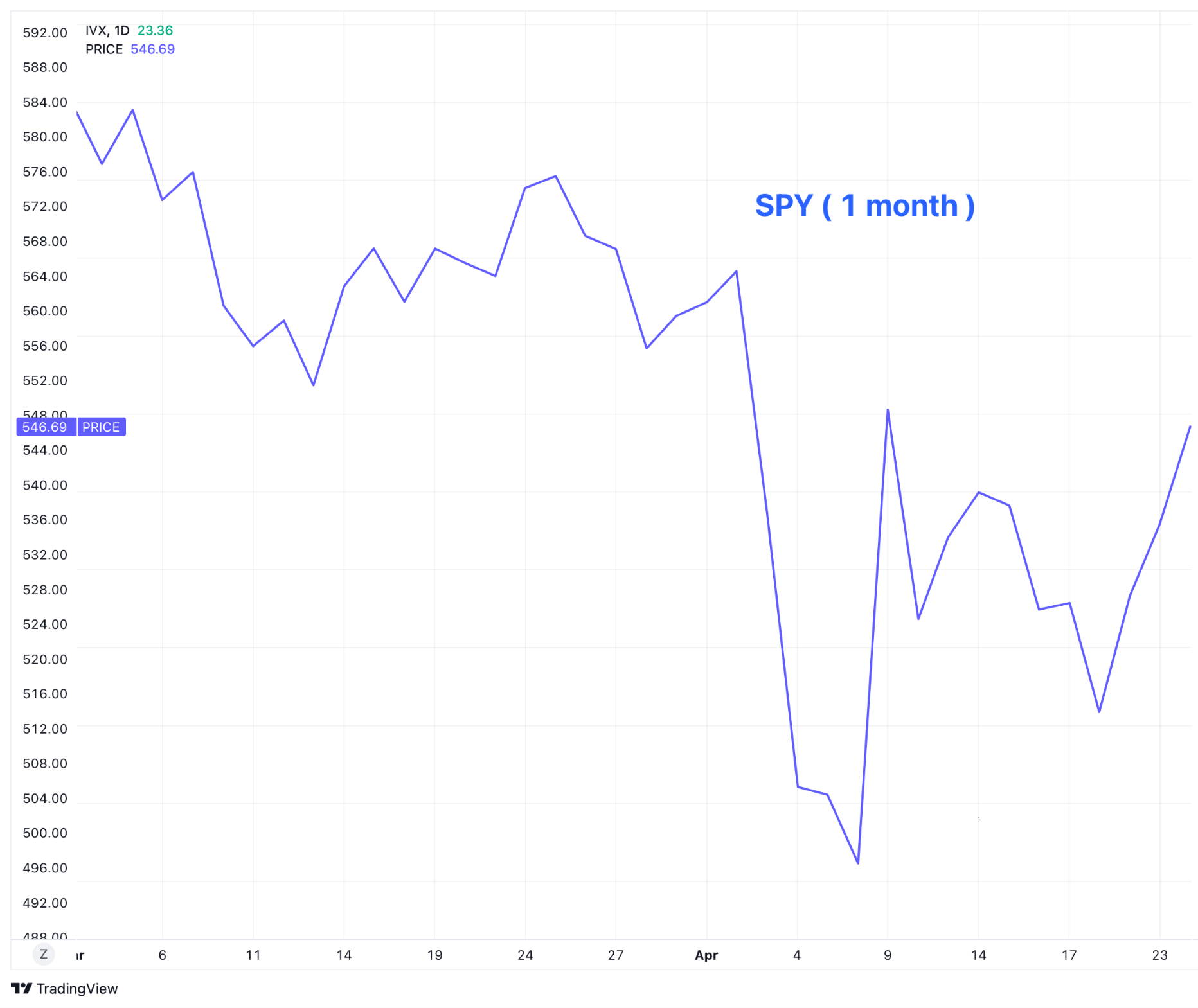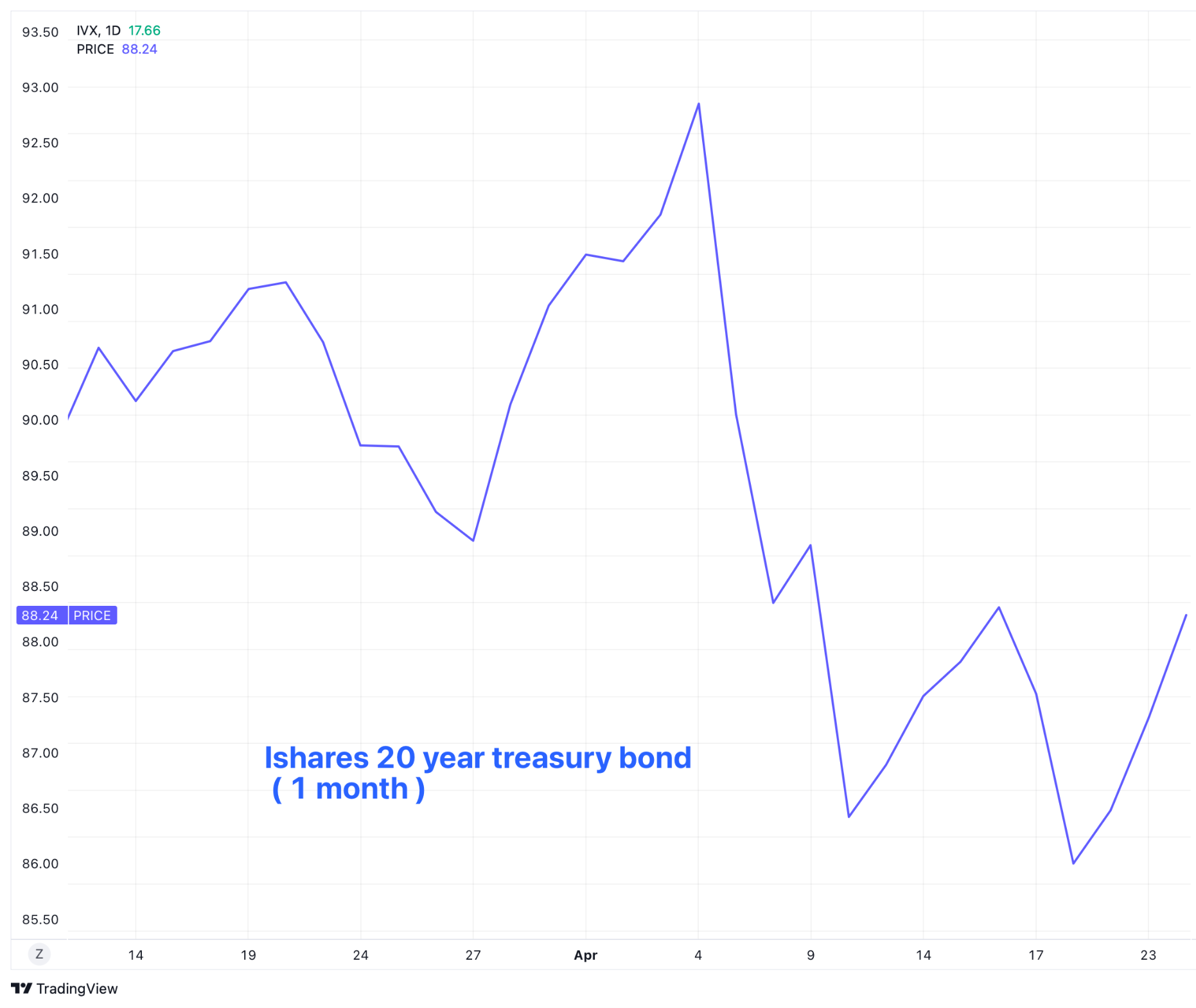Federal Reserve Speaks
April 28, 2025
The Markets at a Glance
The discussion in Capital Markets ought to be about innovation, discovery, imagination and growth. But the choice of gold over a broader market index that represents the cumulative growth prospects of the most innovative companies of the world is alarming. Could this be the collateral damage of the US-imposed tariffs?
Some items to be considered:
- Is there an underlying optimism apparent in the markets?
- Investors are still on edge as evidenced by the continuing gold rally.
- The tariff deals are visibly absent and the window of time is fast diminishing.
- The damage may already be visible with layoffs and poor guidance in earnings.
- Drama between the Federal Reserve and the Executive branch.
- Bitcoin movement resilient.
- Earnings season is upon us.
It seems difficult for analysts and investors to parse the Capital Markets. With volatility still elevated, portfolio swings could continue to be dramatic. Options traders do benefit from elevated volatility because premiums are rich. Still its crucial to keep positions smaller than normal, and actively manage risk.
Some important market profiles are presented below:



The chairman of the Federal Reserve bank, Jerome Powell, was cited as not juicing the flagging economy by cutting interest rates in a timely fashion. However, the constant news of tariffs being applied, escalated, cancelled and/or delayed appeared to be the biggest factor in disturbing investors and moving markets.
Since the beginning of. 2025, stocks have tanked, the bond market is wobbly and the dollar is weaker. This week, the IMF revised its forecast of the odds of a recession from 25% to 37%. The IMF downgraded US economic growth to 1.8%, down from an expected 2.7%.
In 2024, for every USD European investor allocated globally (as measured by etf flows), 50c came to the US. In 2025 thus far, that investment has been an abysmal 3c. With the USD cheaper, investments should rise but instead we may have an unintentional consequence of the overhang of the uncertain, even failing, US fiscal policies.
The past few months have been particularly turbulent for bitcoin. At the beginning of 2025, bitcoin skyrocketed to nearly $110,000 but, with geopolitically-shifting tariffs, the prices have dropped sharply along with other cryptocurrencies and the broader capital markets.
It seems that more and more corporations and institutions are buying bitcoin and more and more governments are holding it as a strategic reserve. The price of this "digital gold" did begin to rebound over the week, jumping over 10%. Perhaps investors are treating bitcoin as a safe haven from geopolitical uncertainty?
Daily Recap
Monday: It appears that the downward spiral of the Capital Markets may have returned. Though volume was light (European markets were still closed in observance of the Easter holiday), the direction of the markets was definitely lower.
Lack of progress around trade talks put U.S. Treasuries back in the hot seat at the start of the week. The bond market responded by heading lower, essentially asking to be compensated for duration due to uncertainty about the treasury conditions over time. Traders are back in the mindset of "sell America".
Tuesday: It was a turnaround Tuesday in markets, with a reversal of fortune for most major asset classes. Whereas Monday saw weaker stocks, bonds and the US dollar, and stronger gold and bitcoin, Tuesday saw the opposite occur.
The S&P 500 was up over 2% as traders may have seen the weakness of thin trading volumes at the start of the week as an opportunity to return to the market at more favorable prices.
One of the clearer signs of relaxation across asset classes is the U.S. dollar is no longer bleeding out across the board. The two biggest beneficiaries of the greenback deleveraging have been the euro and the Japanese yen, which were among the loss leaders in Tuesday's session.
Investors poured almost $1 billion into bitcoin exchange-traded funds.
TSLA earnings were on deck after the market closed. The company missed expectations by 51.61% while revenue fell 9.23% compared to the same quarter a year ago.
Wednesday: Financial markets rebounded Wednesday as the US administration appeared to walk back threats to fire Federal Reserve Chair Powell and signaled a softer stance during ongoing negotiations with China on tariffs. Stocks with higher exposure to China that had sold off in recent weeks rallied. However, by day's end, the euphoria subsided and major averages ended the session well off their highs.
Gold fell and bitcoin rose as investors took on more risk. Oil dropped on reports from OPEC that there may a hike in crude output in the near future.
Thursday: The S&P edged higher as China called out the "absence" of tariff talks with the US administration. This was in contrast to news from the White House that "active" negotiations were on-going with China in an effort to de-escalate the trade war. "Reports on development in talks are groundless", reported the Chinese Ministry of Commerce spokesman. "Fake news", were the words of the Chinese Ministry of Foreign Affairs spokesperson.
It appears that any deal between the two countries may not happen for the foreseeable future.
Equity index futures continue to be dragged along by the latest twists and turns from the White House, but the week's barrage of earnings releases continued full steam ahead; 24% of S&P 500 companies reported this week.
The silver lining to all of the recent noise in the news has been the fact that the bond market isn't showing signs of distress in the manner that it did at the start of the month. The long-end of the curve is lifting more than the short-end.
Also the apparent softening of the US-led global trade war initially resulted in sharp drops in gold prices this week. The drop appears to be short-lived since the overnight comments from Chinese officials led traders back into the shiny metal.
Friday: Difficulties with forecasting and supply chains are the main concerns with corporate earnings announcements. There appears to be no clear trend at this moment even though tech stocks appear to be driving an underlying rally. Even with strong earnings results, concerns about headwinds due to shifting economic policies are clearly evident.
Strategies to Consider
- Short put spread in IWM
expiration: June 20th
strikes: 170/185
delta: bullish
probability of profit: 70%
probability of 50% profit: 86%
credit received: $275
buying power held: $1223
max possible profit: $275
max potential loss: $1225
variations: naked short put; control delta and buying power with strike selection - Call Broken-wing Butterfly in NFLX
expiration: Jun 20th
strikes: 1180/1200/1240
delta: slightly bearish
probability of profit: 77%
probability of 50% profit: 87%
credit received: $230
buying power held: $1770
max possible profit: $2230
max potential loss: $1770
With the big run up in price since the earnings release, this position can be opened. It is an omni-directional strategy that has no risk to the downside. The position can be profitable if NFLX expires below 1180 and additionally profitable if NFLX climbs to 1200. The breakeven is around 1220 after which the position starts losing money.
variations: call ratio with no long call purchase to limit buying power; control delta and breakeven point with strike selection - Capitalizing on large downside moves in the market
The 1-1-1 strategy can be employed to take advantage of downside moves in the markets. This strategy generally consists of buying a wide ATM put spread and financing it with the sale of a short put, all for a small credit.
Buy the SPY may16 546/536 long put spread
Sell the SPY may16 510 put
Total credit: 18c
Buying power deployed: 7585
Breakeven: SPY at 500
Max profit: $1018 if SPY expires between 510 and 536 by May 16th
Management: if SPY breaches 510, close the long put spread for near max value of $10 and roll the 510 down and out in time
Max loss: if SPY drops all the way to zero by may16 and no management is employed
Considerations for the Coming Weeks
The earnings season is in full swing. With volatility so high, one could skip earnings positions in individual underlyings and avoid the news risk. The market etfs and commodities provide sufficient choices for premium plays.
With the news out of the way, post-earnings positions can provide interesting opportunities (see NFLX above).
In Case You Didn't Already Know This...
When material, nonpublic information is used to buy/sell a publicly traded financial instrument, it is called Insider trading.
Who is an Insider: a person who has access to confidential or "inside" information about a company.
What is Material, Non-public information: information that is not available to investors but this information can influence investment decisions. For example, announcements about earnings, mergers and/or product introduction or recall.
When is Insider Trading legal: when strict regulatory rules are followed and reported to the SEC.
When is Insider Trading illegal: when insider information is used to open/close positions in underlyings before the information is available to the general public.
Questions / Comments
We're here to serve IVolatility users and we welcome your questions or feedback about the option strategies discussed in this newsletter. If there is something you would like us to address, we're always open to your suggestions. Use support@ivolatility.com.
Previous issues are located under the News tab on our website.